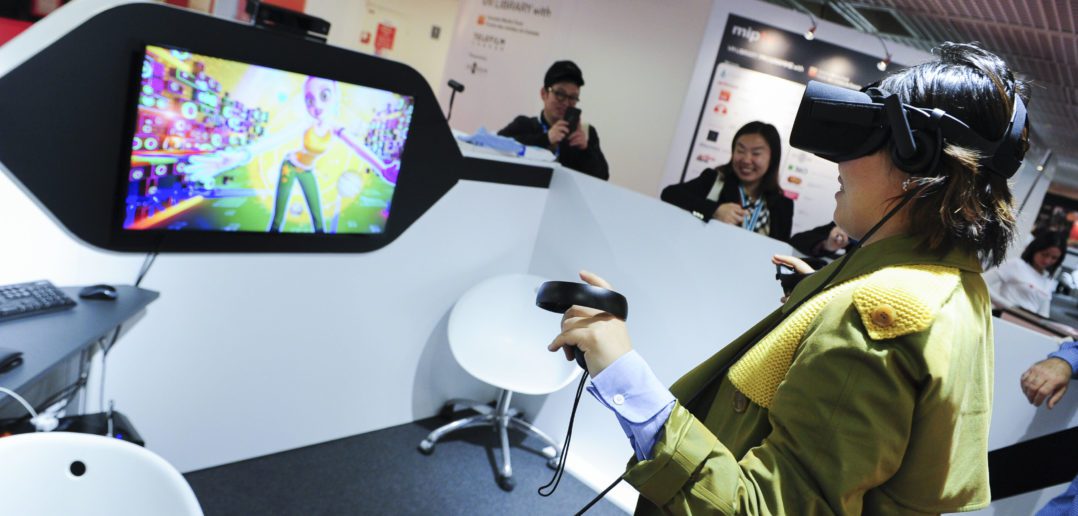This is the latest in a series of posts by the MIPTV News team, summarising the highlights of an action-packed week in Cannes. More soon!
MIPTV’s conference programme once again featured a string of panels examining the future of the TV industry with topics ranging from UHD TV, next generation analytics and the Next Gen Showcases, which included panels on the future of storytelling, virtual heroes and producing shows for Instagram.
Referring to the immersive technologies that have until recently been widely regarded by the traditional entertainment industry as nascent and by extension, experimental, Victor Agulhon, CEO of Parisian VR/AR Studio Targo, told MIPBlog “we are now beyond the ‘it’s-too-early-for-us’ moment.” That fact was reflected in the number of panels and participants exploring the creative potential of AR and VR this year.

This issue was picked up at the True VR: Gearing Up For An Interactive Watching Experience discussion (above). The panelists agreed that the rule book for classic 2D TV has no place in the VR world: “You have to throw away the traditional language because in a 360º world there’s no frame, the viewers create their own. So you have to use the characters to direct viewers to where they should look,” Jonathan Flesher, corporate vice-president, business development, Baobab Studios, said. Alina Mikhaleva, co-founder and managing partner, Spherica VR Studio agreed: “Basically you have to start by forgetting everything you know,” she said.
 The issue of future content was also front and centre at the If Content Is King, Will Blockchain Spark The Revolution? panel. Ashley Turing, CEO of Livetree Adept (above), believes that the technology has a long way to go: “We’re still at a very rudimentary stage of what blockchain technology can do. However, this is the first time in human history that we’ve been able to make a transaction without a third party. And that’s really exciting in itself,” he said. Adrian Garelik, CEO at Flixxo added: “The content isn’t in the blockchain. The blockchain is more of a backbone. It’s like an environment in which content creators can own their community; the land they build their house on, if you like.”
The issue of future content was also front and centre at the If Content Is King, Will Blockchain Spark The Revolution? panel. Ashley Turing, CEO of Livetree Adept (above), believes that the technology has a long way to go: “We’re still at a very rudimentary stage of what blockchain technology can do. However, this is the first time in human history that we’ve been able to make a transaction without a third party. And that’s really exciting in itself,” he said. Adrian Garelik, CEO at Flixxo added: “The content isn’t in the blockchain. The blockchain is more of a backbone. It’s like an environment in which content creators can own their community; the land they build their house on, if you like.”
The ‘how to?’ question is also hugely relevant to the growing appetite for video content on platforms such as Facebook and Instagram. The session on How To Produce A Series For Facebook Watch clarified the distinction between posting videos on the social network’s News Feed and the new platform, which focuses on video-first storytelling entertainment. Stone Roberts, senior vice-president global video strategy at Refinery29, the digital publisher targeting millennial women, gave his opinion: “I would describe Watch as a long-form video-first environment within Facebook. And a Show Page is similar to a Facebook Page, but it has additional benefits such as delivering content in Watch, introducing a trailer in the cover spot, branding with a show mark, organising episodes into seasons and automatically adding new episodes to the Watch list of followers.”
Jeroen Koopman, owner/creative producer at Amsterdam-based digital production outfit NewBe sounded a word of warning about audience expectations: “Your audience needs to be engaged within the first three seconds, then use the next 10 seconds to explain what they are going to see. But it is still new and everyone is trying to figure out what the best practices should be.”

Instagram has become an essential tool for boosting business in today’s content business, speakers said during the session called How To Produce A Series For Instagram. Joanna Wells, vice-president, digital at MTV International and Comedy Central (Viacom International Media Networks, above) was encouraging: “We were early adopters because we wanted to be ahead of the curve, especially at MTV. We want to be everywhere the audience is. It is about understanding what the platform requires. My advice to producers is not to be afraid. For every post, you are taking the viewer to your home page to get them to follow you. Then, learn how to cross promote that on other platforms.”

Hyppe Salmi, executive producer at Finnish public broadcaster YLE (above) is charged with sourcing content such as Karma for YLE’s linear platform and VOD service Areena. Karma was the first time YLE commissioned an Instagram-only series. It was a bold experiment shot with only a smartphone and transmitted in real time over three days. “The three actresses in it lived together over the three days and used the viewers’ real-time comments in the story’s development,” Salmi said. “Karma was real-time drama so there was no trailer to market its launch. You have to think about the audience and how they will use the content too. This meant the length of each episode varied depending on the storyline.
Karma was shot in real time, so YLE had no clue when the viewers would be using Instagram. “At the time of transmission, you don’t know who is still watching or who has gone off to do other things. That makes a huge difference to the way you approach your script,” Salmi added.

At a time when international content providers are commissioning local content aimed at audiences in specific countries, digital connections are enabling local fans to share their enthusiasm internationally. Parrot Analytics aims to help makers of local hits to assess whether that popularity can spread outside the home market and, if so, how to go about making it happen, referred to by Parrot as content travelability.
“The usefulness of the travelability metric is that, for the first time, the industry can precisely quantify the ability of shows to appeal across borders,” said Samuel Stadler, Parrot Analytics’ marketing manager (above right, with Stefan Nordbruch). “In a world of SVODs, we want to give data a seat at the decision-making table.”
It does so by trying to find answers to a series of questions such as; How can a producer know that they should capitalise on fans that they don’t know exist? How can a distributor develop pricing models for regions where a show hasn’t aired yet? How can global platforms commission content for maximum appeal with minimum cost?
The popularity of UHD and 4K TVs continues to grow rapidly. Paul Gray of IHS Markit gave an update on the global market. “4K TV shipments continue to grow,” he said. “The 4K set now represents over half of the sets shipped in North America and Europe, and two-thirds of those in China.” Screen size is increasing too, and the average size of Western European screens is catching up with that of North America, despite very different home sizes. “UHD screens are getting very big. The Chinese believe that consumers want a 65- or 75-inch screen. And they’re very cheap. Last week a reputable brand was offering a 65” screen for $610. We believe that 55” will out-ship 32” by the end of 2018.”
Find more digital trends in MIPTV 2018’s full live coverage reports, here; and interviews with key speakers mentioned above — including Viacom’s Joanna Wells and YLE’s Hyppe Salmi — in The MIPTV Show, here!




